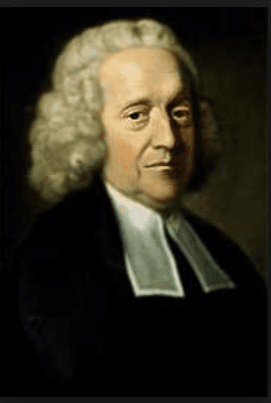Joseph deBettencourt
Chicago, Illinois, United States


“It would but ill become us in this our State of Uncertainty, to treat the Errors and Mistakes of others with Scorn and Contempt, when we ourselves see Things but as through a Glass darkly, and are very far from any Pretensions to Infallibility”
— Stephen Hales, Haemastatics
Stephen Hales’ father died when he was fifteen, and the following year his brother, Sir Thomas Hales, succeeded to the baronetcy. Stephen, the sixth son in his family, was not destined for titles or a seat in Parliament. He was destined for the clergy.1 As a child of nobility, his life was fairly structured, and studying divinity at Cambridge was a respectable career. His time at Cambridge, however, widened his perspective and his interests. Outside of his theological studies he began to attend lectures on chemistry given by a professor named Giovanni Francisco Vigani. Little is known about Vigani’s early life, but what is known is that he made his way from Italy to Cambridge and studied almost anything he came across. Despite having no particular credentials, he became the first professor of chemistry at Cambridge.2 Perhaps Stephen Hales time spent learning from this self-taught scientist inspired him to begin his own career as an amateur scientist. Whatever the inspiration, Stephen Hales became enamored with science as a way to better understand his religious beliefs.
For Hales, the intricacy and detail of nature was proof that there was an all-powerful architect of this world, “. . . who could be so senseless as to say in his Heart, that there is no God; whose masterly Hand is so evident in every Part of Nature. . . .”3 Hales began his studies with plants, creating a series of experiments to elucidate their physiology. He measured their water consumption and loss, as well as the pressure exerted on the sap within a plant’s stalk. Every experiment and observation he made delighted him. “The farther researches we make into this admirable scene of things, the more beauty and harmony we see in them: and the stronger and clearer convictions they give us, of the being, power and wisdom of the divine Architect.” 4
His religious zeal served his studies well, and pushed him to continue his work despite the often-gruesome nature of his experiments. As he expanded his studies into the realm of animals, he sought to repeat many of the experiments he had conducted on living plants. He would become the first to make measurements of blood pressure in animals by inserting tubes into their arteries. He measured the height the blood would reach in the upright tube, which allowed him to calculate the force required to pump the blood to that height. “The Disagreeableness of the Work did long discourage me from engaging in it…” he wrote in the introduction of his book, Statical Essays: Haemastatics. These experiments and the deductions he made about the physiology of the circulatory system earned him a place in scientific literature. His invention of devices also made him well known in medical circles, but his work was born out of more than curiosity. He was looking for the architecture, the system behind his world.
Hales published Statical Essays, the account of his hematological experiments, in 1731, eleven years after the death of his wife. Hales had been married for all of one year when his wife died in childbirth and he never remarried. After that time, he devoted himself to humanitarian efforts, his experiments, and designs that he felt would better society.1 He was well known for installing a rudimentary ventilation system on a prison, intending to provide healthier, cleaner air for those incarcerated.5 Little has been written on Hales and his personal life, but from his own words it is clear that his work was how he connected with the world and how he made sense of his life. Stephen Hales was destined to a life in the clergy from an early age, but his search to understand his life and the world around him provided him much more than space in a history textbook. It gave him access to his faith and comfort in his life.
“In which there is so just a Symmetry of Parts, such innumerable Beauties and Harmony in the uniform Frame and Texture of so vast a Variety of solid and fluid Parts, as must ever afford Room for farther Discoveries to the diligent Inquirer; and thereby yield fresh Instances to illustrate the Wisdom of the divine Architect.” – Stephen Hales4
References
- Clark-Kennedy AE. Stephen Hales, DD, FRS. Br Med J. 1977;2(6103):1656-1658.
- Ph.D LJMCMAMS. John Francis Vigani. Ann Sci. 1952;8(1):46-60. doi:10.1080/00033795200200042
- Hales S. Statical Essays: Haemastatics. Innys; 1740.
- Hales S. Statical Essays: Containing Vegetable Statics; Or, An Account of Some Statical Experiments on the Sap in Vegetables. Being an Essay Towards a Natural History of Vegetation … Also a Specimen of an Attempt to Analyse the Air, by a Great Variety of Chymio-Statical Experiments, Which Were Read at Several Meetings Before the Royal Society. Wilson and Nicol; T. Durham; G. Keith; and Robinson and Roberts; 1769.
- Stephen Hales | English scientist | Britannica.com. https://www.britannica.com/biography/Stephen-Hales. Accessed October 2, 2018.
JOSEPH deBETTENCOURT is a medical student at Rush Medical College in Chicago, Illinois, with an interest in pediatrics. He attended Northwestern University where he received a BA in Theatre and Pre-Medical Studies. He has worked as a professional actor, designer, and carpenter, as well as a standardized patient, and medical researcher.

Leave a Reply